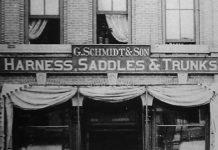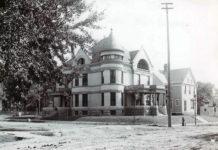
Just over one hundred years after the first train passed through the scenic Red Jacket Valley, the Milwaukee Road abandoned the right-of-way of land used for train traffic. Today the area is well known for the trail that was built along this track in the 1990s, but far fewer are able to remember the days when the train traveled through the countryside.
An Exciting Development
In the late 1860s, word had circulated that three men on horseback were seen fording the river just below the Red Jacket Mill dam and riding toward the long ravine. They were rumored to be searching for a possible railroad route. Predictions of a post office and hope of a Red Jacket depot was the talk among the people in the valley.
The Southern Minnesota Rail line had reached Wells by the summer of 1869. Financial problems delayed construction at times, but by the summer of 1870 surveyors were busy on the next segment, from the Maple River to the Red Jacket Mill. They were looking for the easiest grade in the vicinity of the LeSueur River. There was some consideration of a possible tunnel, but a route down the Red Jacket ravine was finally decided upon.

By early autumn there were seven shanties for the construction crews between Mankato and the Red Jacket Mill and twelve more in the ravine itself. By October 11th about twenty miles had been graded between Wells and the head of the ravine and there were four hundred men working on this stretch. The contract had been awarded for the construction of the long trestle that would carry the railroad across the LeSueur River at the Red Jacket Mill. Stone was being hauled for the piers and culverts in the ravine.
First Setback
Construction was halted due to financial and legal disputes that resulted in a change of ownership with the name being changed to Central Railroad. It wasn’t until June 24, 1874 that work began again on the ungraded stretch of the line between Mankato and the north end of the grade that had been completed at the ravine in 1870. By the end of June enough iron had been brought in to lay the track as far as Good Thunder and more supplies were arriving daily. By August 4th the track reached the LeSueur River.
Construction Continues
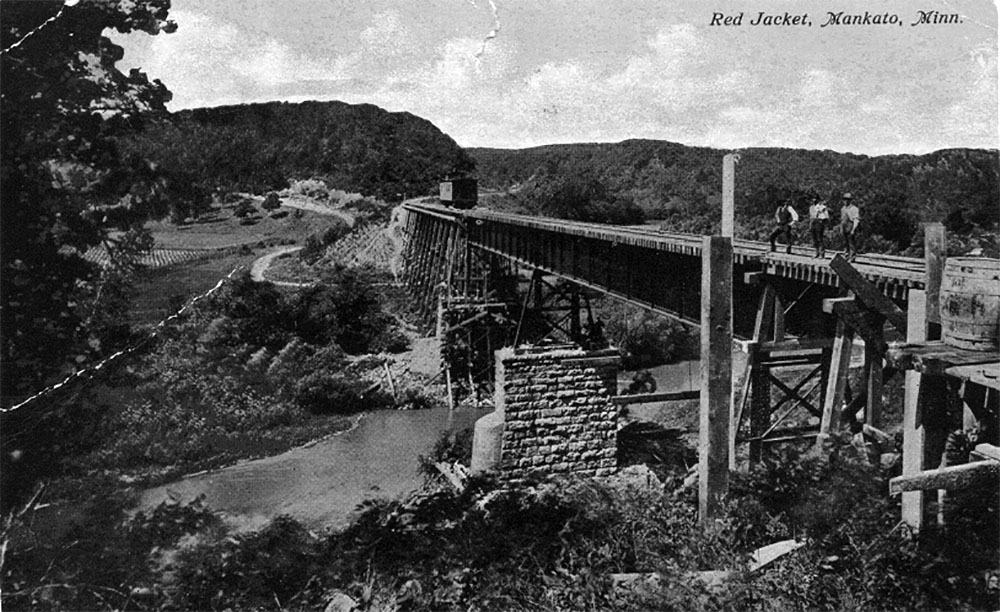
There were ten trestles built within the section of line between Mankato and Good Thunder. The Red Jacket trestle and railway bridge being the largest, was completed in September 1874. The LeSueur River is crossed by a Howe truss railway bridge 183 feet long, constructed of wood except for tie rods, bolts, etc. and is supported by two massive stone piers. The top of the railway bridge was 53 ¾ feet above the water and the trestle connecting the bridge with the bluff was 618 feet long. Its highest point was 59 feet above the ground.
The track finally reached Good Thunder on September 24, 1874 and a daily train each way between Mankato and Good Thunder was put into operation. The construction to complete the line to the southeast, beyond the Maple River proceeded rapidly and was fully completed by November.
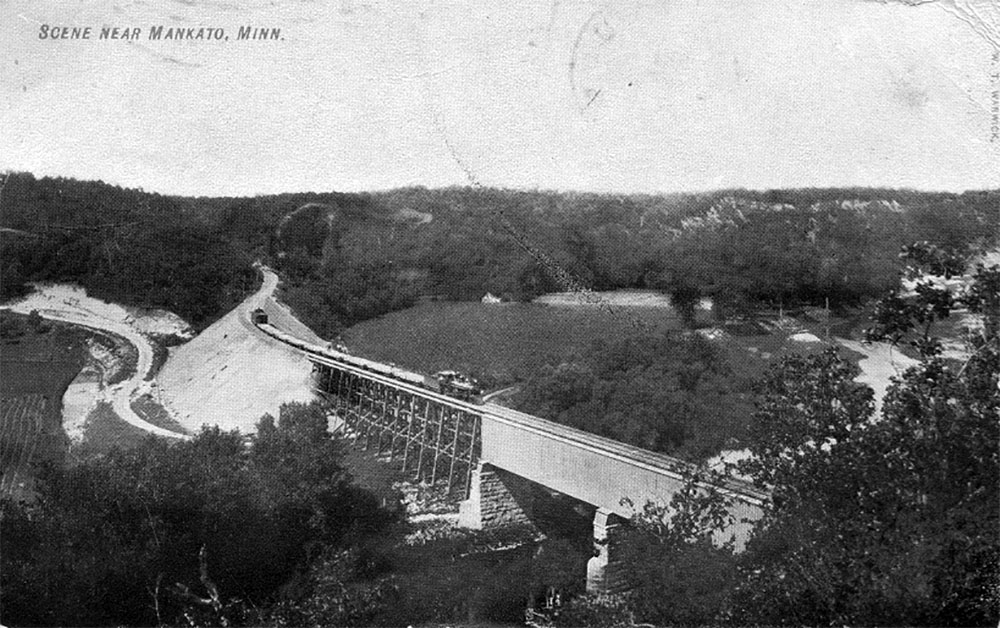
On November 10, 1874, the members of the Mankato city council, township officials and officials of the railroad enjoyed an excursion from Mankato to Wells. The long awaited southern connection was finally a reality.
Problems for the Central Railroad
The Central Railroad was plagued by financial problems, controversy and complaints. Repeatedly complaints were made about the quality of service and passenger accommodations left much to be desired.
The Central Line seemed to suffer more than its share of interruptions of service due to landslides and heavy snow, especially in the Red Jacket ravine. Only a few months after it began operating, the train from Wells was halted by snow just north of Good Thunder. Five or six passengers spent the night in the car and the train employees dug it out in the morning.
A week or so later the locomotive, baggage car and passenger coach left the track as the train was trying to push its way through snowdrifts. The next summer a heavy landslide occurred in the ravine, covered the track to a depth of eight to ten feet in places and bent the rails. A temporary track was laid on top of the dirt and trains were able to get through, with difficulty, until the dirt was cleared away.
In May 1876 the passenger train was again forced to go back by a landslide in the same place. A washout in the Red Jacket ravine occurred in July 1879. Workmen had dug a pit near the right-of-way and it soon filled with water that had drained from the hills. Finally the pressure caused the bank to give way. Two men who were out picking berries heard the roaring of the water and were able to signal the train in time for it to stop. The passengers had to walk the four miles back to Mankato.
Red Jacket Mill Station
The railroad established a station at the Red Jacket Mill sometime prior to 1878. In that year, the Railroad Commissioner’s report listed “Red Jacket” among the five stations on the Central Railroad of Minnesota.
The station never conducted a large amount of business. It reached a peak in 1880 with receipts of $19.60 in passenger fares. By 1880 the Central Railroad line had been officially transferred to the Chicago, Milwaukee & St. Paul line.
Wood or coal was used to heat homes and the farmers who lived along the railroad would engage freight flat cars to haul their wood to market. Cords of wood would be piled near the railroad and there was strong competition as to who would get the cars first. When they saw a line of cars coming, each man would grab a wood stick with his name on it and throw it onto the first empty car he saw to mark it as his. The wood was hauled to town and sold.
A Part of Everyday Life
Adjustments and expansions for the railroad had settled down into a stable pattern in the first decade of the 20th century and the train service had become an integral part of life. Residents traveling any distance out of the area would generally travel by train. They could travel to the depot nearly any time of the day and catch a train. Even short excursions were popular. Typical were theater parties formed by young people at Good Thunder and Rapidan. They would arrive in Mankato on the train at 7 p.m., see a movie and return home on the 10 p.m. train. Shoppers would come to Mankato by train and return home on the evening train.
With the automobile becoming increasingly prevalent, trains became less important. The passage of time saw passenger service decrease until it was finally abandoned in the early 1960’s. Freight service had also decreased substantially. By 1978 the Milwaukee Road had abandoned thirty miles of track between Mankato and Minnesota Lake.
An effort was made to have the Red Jacket Trestle placed on the National Register of Historic Places, but after some study, it was concluded that changes had been made to its structure over the years.
The historic trestle was saved when the Red Jacket Trail Task Force and local citizens succeeded in developing the 5.6-mile long recreational trail. The dream of the Red Jacket Trail became a reality when it opened in the fall of 1997.
Red Jacket Bridge
In the 1850s, roads were merely paths from which the trees had been cut and cleared. The early road leading through the Red Jacket Valley was once an Indian trail. In the “History of Blue Earth County,” Thomas Hughes describes this road. “The ancient Indian trail led from the Big Woods and the Minnesota Valley though Mankato, along the foot of Walker hill, down through the Red Jacket Valley and by the site of the old fort [Fort LeHillier], crossing the LeSueur just above it’s mouth and passing up the opposite bluff followed in a southwesterly course over the Blue Earth and Watonwan.”
Road Improvements
Rough, dirt roads made traveling by horse and wagon a difficult venture. Most often the passengers arrived weary, jolted and bruised at the end of their trip. Spring rains left the roads deep in mud and almost impassable for horse and buggy. By the early 1900’s, automobiles were making their appearance and by 1905 an effort was made for improved roads in the county. An article in the Mankato Free Press, June 22, 1906, describes the split log drag.
“A drag is easy to construct and simple to operate. It may be made from a log, three stakes and a piece of wire, with an axe and a two-inch auger. The implement certainly is so simple and cheap that any farmer who has a team can own one. A twelve-year-old boy can operate it. The testimony of all who use the drag is that it “delivers the goods.” Every road district in Blue Earth county should have a drag and operate it whenever the condition of the roads require it.”
Soon graveling bees became community events. Gatherings were held at a gravel pit, refreshments added to the occasion and the farmers dug the gravel to fill the holes in their roads.
Graveling, grading and other improvements date back to 1912 when the county was still struggling to support its own roads. The state trunk highway system with pavement and other improvements came eight years later with the passage of the Babcock law. First through the automobile license tax and later through the present gasoline tax, funds were provided to carry on the work of road improvement. Highway 66 as we know it today was constructed in 1911. The road was first blacktopped in 1948.
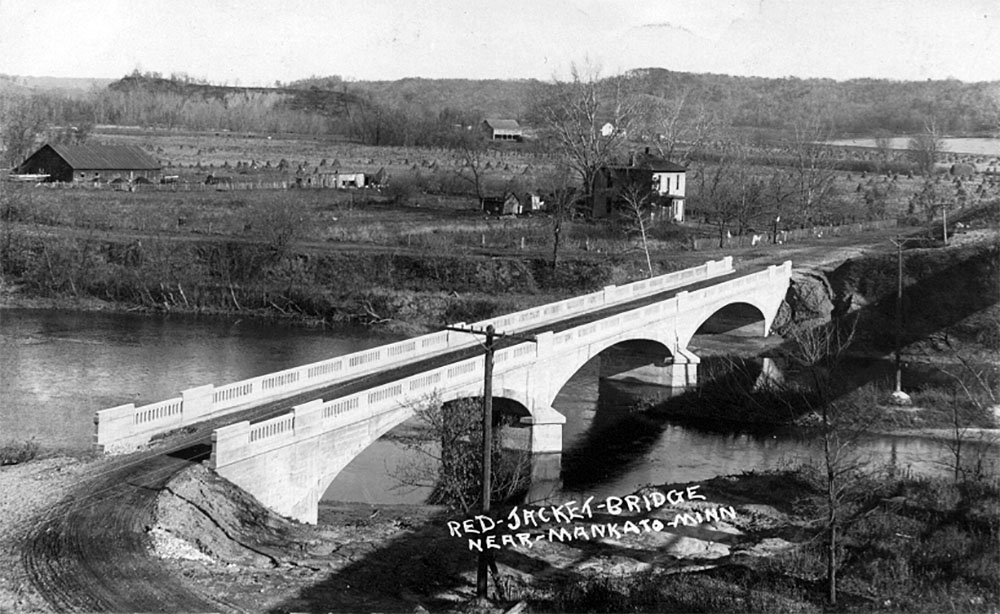
Construction of Highway 66 included a one lane concrete bridge to be built at the site of the Red Jacket trestle crossing the LeSueur River. The long awaited bridge at the Red Jacket crossing was celebrated by the people with an elaborate dedication held on August 22, 1911.
The following are excerpts from the Mankato Free Press, August 22, 1911:
BRIDGE IS A BEAUTY – GIVEN GRAND OPENING
Celebration Yesterday at Red Jacket Great Success
“The new bridge at Red Jacket, the best by far that has yet been constructed in this county, if not in Southwestern Minnesota, was given an appropriate sendoff yesterday by several hundred people, gathered in a beautiful piece of woodland near one end of it.
“Probably 500 to 700 people were gathered beneath the shade of the beautiful hard maples and butternuts in Frank Pearson’s pasture, where a dinner ‘such as mother used to prepare’ was served by the ladies of the surrounding country.
“The beautiful structure, with its graceful arches and picturesque balustrades, was admired by all. The bridge opens a new road direct to Good Thunder and all that territory, saving fully a mile over any other route. The Strand ravine road that connects at the south end of the bridge has only a seven per cent grade. People driving this way take the left hand road after crossing the bridge. The bridge also makes a new and more direct road to the Rapidan dam.
“The new bridge was built by the J.B. Marsh Engineering company of Des Moines, Iowa, at a contract price of $13,200.”
Description of Bridge
“The bridge is 276 feet long, sixteen feet wide in the clear, and has three arches, each 71 feet long in the clear, and the bottom of the arches stand eighteen feet above low water mark and five or six feet above the highest point that the river has ever been known to have reached, within the memory of the oldest inhabitants. The bridge looks low in comparison with the immensely high railway bridge beside it, but the later had to be high in order to conform with the grade of the road. If by itself, the wagon bridge would look as high as any other bridge.
“In the construction of the bridge, about 1,400 yards of concrete were used, and J.B. Marsh, who was present yesterday at the picnic, stated to The Free Press that the bridge would hold up 200 pounds to the square foot, or a double row of twenty-ton threshing engines extending across the bridge, without straining it. Yet one farmer, before assuming the risk of driving across the bridge yesterday, got out and walked ahead and tested the structure with his weight to see if it was safe.”
Photograph Was Taken
“When the afternoon passenger train for the south came by, it stopped on the bridge for about five minutes, and the picnickers were all asked to assemble on the wagon bridge, and photographs of the two bridges were taken by J.R. Snow. Refreshments were provided for the train crew. A number of Mankato people came on this train and returned on the north bound one early in the evening, which stopped for them.
“Lamm’s five piece orchestra assisted with the speaking program, by rendering selections on the stage that had been built for the occasion. This meeting was presided over by former County Commissioner Schultz with grace and dignity.
“Flags had been placed on all sides on the fence posts and in the trees, to mark the picnic grounds. Mr. Pearson donated the use of the pasture and assisted in hauling the lumber, the use of which was donated by the Marsh Engineering company. This company also supplied the lemonade free.”
Origin of Celebration
“The celebration was originated by Charles C. Johnson and George Yaeger, two live wires of the section of the county benefited by the bridge, and they appointed committees to have charge of various features. Mrs. G. Harris decorated the bridge nicely, with flags, bunting and red jackets, a thought that struck everyone as appropriate. The general committees for the banquet, etc., were composed of Mr. And Mrs. George Yaeger, Mr. And Mrs. C.C. Johnson, Miss Clara Yaeger, Miss Louise Yaeger and Miss S. Erickson.”
An Abundance of Lunch
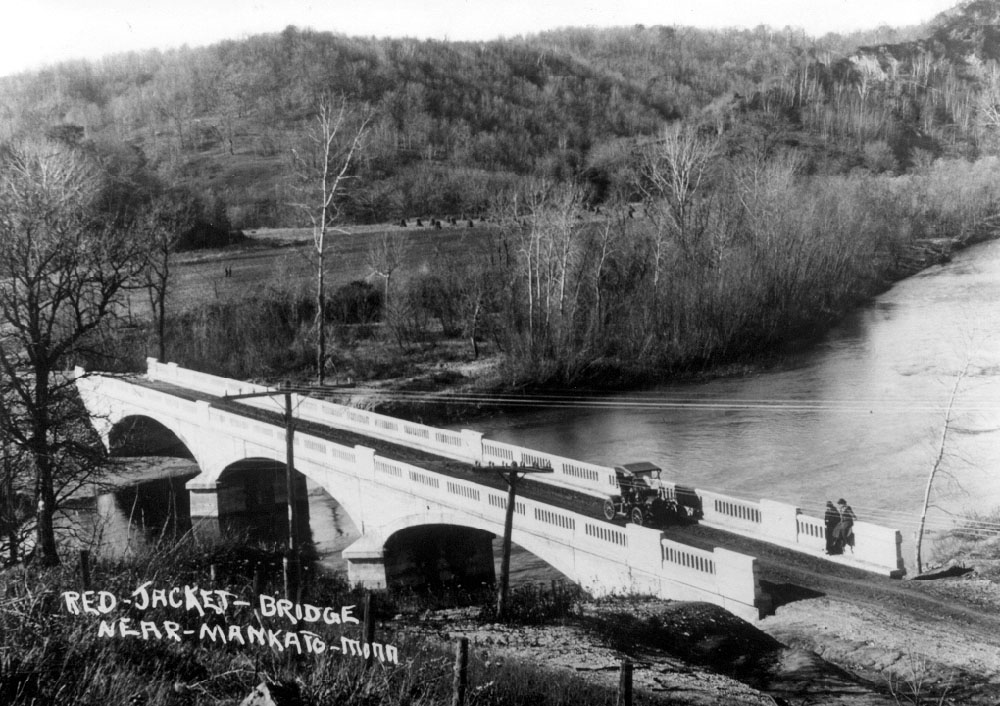
“Such an abundance of lunch was prepared that quantities had to be packed up and taken away. Some of the picnickers had supper and remained until dark. A big wagon load of homegrown watermelons were brought to the grounds and sold.
“The road to the Red Jacket bridge is one of the most picturesque of the many drives out of Mankato. It runs through a series of little valleys, with the sides heavily clad with forest trees and lower portions cultivated. The road generally follows hillsides and is graveled for the most part with the splendid Indian lake gravel, which is considered superior to any other.”
Modern Update
In May 1960, heavy rains and flooding caused damage to roads, farms and homes. Water poured under the old single lane concrete Red Jacket Bridge before the pile-up of trees and other debris forced it to collapse in the center. The bridge was closed all summer while repairs were made and the bridge widened to a 24-foot span. The bridge was finally reopened to traffic by mid-October 1960.
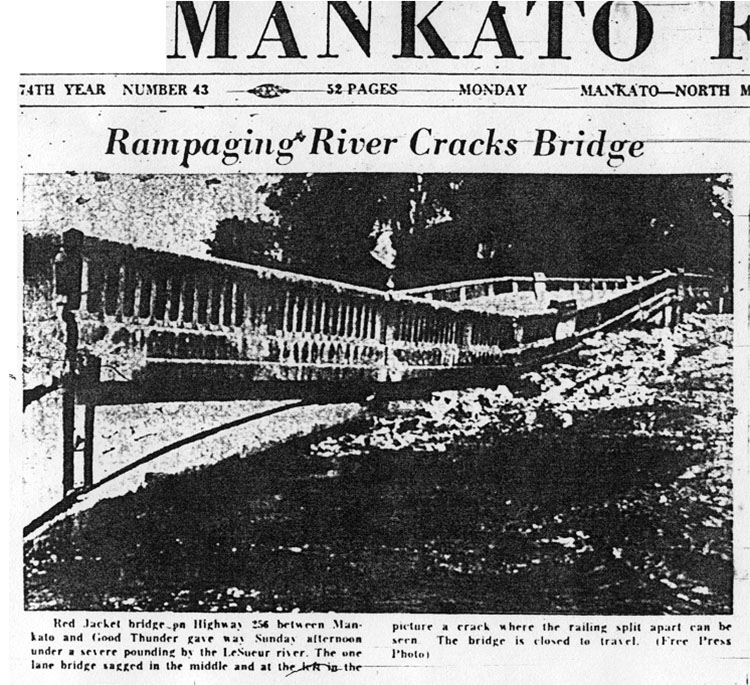
In 1987 the Minnesota Department of Transportation announced a plan to upgrade and realign Highway 66 and to replace the Red Jacket Bridge with a new bridge. At the west end of the old bridge the road turned sharply southward and it required traffic to slow down to 15 mph. The plan was to straighten this curve for safety and better traffic flow. Construction of the new bridge didn’t begin until the summer of 1995.


